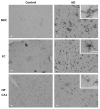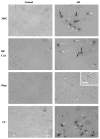Evidence of angiogenic vessels in Alzheimer's disease
- PMID: 19370387
- PMCID: PMC2753398
- DOI: 10.1007/s00702-009-0226-9
Evidence of angiogenic vessels in Alzheimer's disease
Abstract
Alterations in the blood brain barrier and brain vasculature may be involved in neurodegeneration and neuroinflammation. We sought to determine if vascular remodeling characterized by angiogenic vessels or increased vascular density, occurred in pathologically confirmed Alzheimer's disease (AD) postmortem human brain tissues. We examined brains of deceased, older catholic clergy from the Religious Order Study, a longitudinal clinical-pathological study of aging and AD. The hippocampus, midfrontal cortex, substantia nigra, globus pallidus and locus ceruleus were examined for integrin alphavbeta3 immunoreactivity, a marker of angiogenesis, and vascular densities. Activated microglia cell counts were also performed. All areas except the globus pallidus exhibited elevated alphavbeta3 immunoreactivity in AD cases compared with controls. Only in the hippocampus did the ongoing angiogenesis result in increased vascular density compared with controls. Vascular density was correlated with Abeta load in the hippocampus and alphavbeta3 reactivity was correlated with neurofibrillary tangles in the midfrontal cortex and in the substantia nigra. These data indicate that ongoing angiogenesis is present in brain regions affected by AD pathology and may be related to tissue injury.
Conflict of interest statement
Figures




References
-
- Akiyama H, Kawamata T, Dedhar S, McGeer PL. Immunohistochemical localization of vitronectin, its receptor and beta-3 integrin in Alzheimer brain tissue. J Neuroimmunol. 1991;32:19–28. - PubMed
-
- Akiyama H, Ikeda K, Kondo H, McGeer PL. Thrombin accumulation in brains of patients with Alzheimer's disease. Neurosci Lett. 1992;146:152–154. - PubMed
-
- Alzheimer A, Stelzmann RA, Schnitzlein HN, Murtagh FR. An English translation of Alzheimer's 1907 paper, “Uber eine eigenartige Erkankung der Hirnrinde”. Clin Anat. 1995;8:429–431. - PubMed
-
- Bennett DA, Schneider JA, Wilson RS, Bienias JL, Arnold SE. Neurofibrillary tangles mediate the association of amyloid load with clinical Alzheimer disease and level of cognitive function. Arch Neurol. 2004;61:378–384. - PubMed
Publication types
MeSH terms
Substances
Grants and funding
LinkOut - more resources
Full Text Sources
Other Literature Sources
Medical

